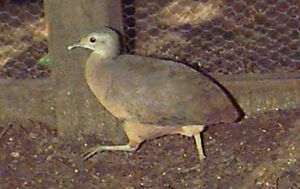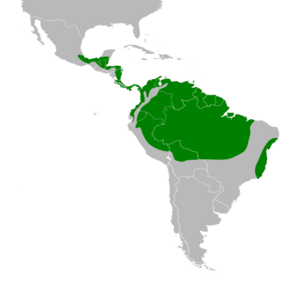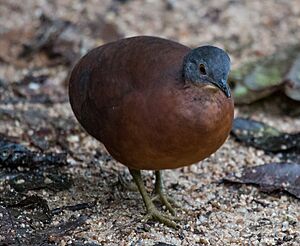Little tinamou facts for kids
Quick facts for kids Little tinamou |
|
|---|---|
 |
|
| Conservation status | |
| Scientific classification | |
| Genus: |
Crypturellus
|
| Species: |
soui
|
| Subspecies | |
|
C. s. meserythrus (Sclater, 1859) |
|
 |
|
| Synonyms | |
|
Tinamus soui |
|
The little tinamou (Crypturellus soui) is a type of bird found in Central and South America. You can also find it on the Caribbean island of Trinidad. These birds are known for being quite shy.
Contents
What's in a Name?
The scientific name Crypturellus comes from three old words. Kruptos means 'covered' or 'hidden'. Oura means 'tail'. And ellus means 'small'. So, Crypturellus basically means 'small hidden tail'. This name fits because these birds have very short tails that are hard to see!
Bird Family Tree
The little tinamou belongs to a group of 21 species in the Crypturellus family. All tinamous are part of the Tinamidae family. They are also palaeognaths, which is a larger group of birds. This group includes well-known flightless birds like ostriches and emus.
Even though tinamous are related to these big, flightless birds, they can fly. However, they are not very strong fliers. All palaeognaths, including tinamous, developed from ancestors that could fly.
Different Types of Little Tinamous
There are many different kinds, or subspecies, of the little tinamou. Each type lives in a specific area. Here are some examples:
- C. s. meserythrus lives in southern Mexico, Belize, Honduras, Guatemala, El Salvador, and northern Nicaragua.
- C. s. modestus is found in Costa Rica and western Panama.
- C. s. soui lives in eastern Colombia, eastern and southern Venezuela, French Guiana, Guyana, Suriname, and northeastern Brazil.
- C. s. andrei can be found in Trinidad and northern Venezuela.
Where They Live

The little tinamou lives in tropical lowland forests. They also like forests near rivers and areas with lots of shrubs. You can find them at heights up to about 2,000 meters (6,560 feet). They can even live in areas where forests have been cleared, like farms or plantations. This shows they are good at adapting to different environments.
Daily Life and Habits
Little tinamous are shy and like to be alone or with their mate. Even though there are many of them, you don't often see them. People usually hear them before they see them. Their call is a soft, whistling sound that goes down in pitch. Both male and female birds make this sound.
They eat seeds, berries, and some insects. They prefer to run away from danger rather than fly, unless they absolutely have to. These birds are very protective of their space. They will defend their territory if another bird tries to enter it. They often stay in the same territory for many years.
Reproduction and Life Cycle
The breeding season for the little tinamou is from May to October. They make their nests in a small dip on the forest floor. Sometimes, they line the nest with a few leaves. Nests are usually found at the base of a tree or in thick bushes.
The female bird performs the courtship dance. After the eggs are laid, the male bird takes care of them. He sits on the eggs to keep them warm, sometimes for up to 14 days without leaving the nest! They usually lay two shiny, dark-purple eggs. The eggs are about 32 to 41 millimeters (1.3 to 1.6 inches) long.
When the young birds hatch, they are ready to go! They can start pecking at the ground for food on their very first day. They can also run almost as soon as they hatch. By 3 to 4 weeks old, they can fly well. They start laying their own eggs when they are about one year old.
What They Look Like
The little tinamou is about 22 to 24 centimeters (8.7 to 9.4 inches) long. It weighs around 220 grams (7.8 ounces). Even though it looks a bit like a quail or grouse, it's not related to them.
This bird has smoky-brown feathers that turn grey on its head. Its throat is whitish. The underside of both males and females is a cinnamon-buff color, but the female's is a bit lighter. Their legs can be grey, olive, or yellow. Both male and female tinamous have very short tails that are almost invisible.
Conservation Status
The IUCN (International Union for Conservation of Nature) lists the little tinamou as a species of Least Concern. This means they are not currently at risk of disappearing. They live across a very large area, covering about 9,500,000 square kilometers (3,670,000 square miles).


